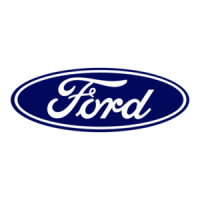01-12
Basic Engine
01-12
CLEANING AND INSPECTION
The cleaning and inspection procedures are for a complete
engine overhaul; therefore, for partial engine overhaul or
parts replacement, follow the pertinent cleaning or
inspection procedure.
Intake Manifold
Cleaning
Remove all gasket material from the machined surfaces of
the manifold. Clean the manifold in a suitable solvent and
dry it with compressed air.
Inspection
Inspect the manifold for cracks, damaged gasket surfaces,
or other defects that would make it unfit for further service.
Replace all studs that are stripped or otherwise damaged.
Remove all filings and foreign matter that may have
entered the manifold as a result of repairs.
Exhaust Manifolds
Cleaning
Remove all gasket material from the manifolds.
Inspection
Inspect the cylinder head joining flanges of the exhaust
manifold for evidence of exhaust gas leaks.
Inspect the manifolds for cracks, damaged gasket
surfaces, or other defects that would make them unfit for
further service.
Valve Rocker Arm and/or Shaft Assembly
Cleaning
Clean all the parts thoroughly. Make sure all oil passages
are open.
Make sure the oil passage in the rocker arm is open.
Inspection
On rocker arm shaft assemblies, check the clearance
between each rocker arm and the shaft by checking the
ID of the rocker arm bore and the OD of the shaft. If the
clearance between any rocker arm and the shaft exceeds
the wear limit, replace the shaft and/or the rocker arm.
Inspect the shaft and the rocker arm bore for nicks,
scratches, scores or scuffs.
Inspect the pad at the valve end of the rocker arm for
indications of scuffing or abnormal wear. If the pad is
grooved, replace the rocker arm.
Do not attempt to true
this surface by grinding.
Check the adjusting nut(s) torque. If not within
specifications, replace the nut(s). Check the rocker arm
pad and fulcrum seat for excessive wear, cracks, nicks or
burrs.
Push Rods
Cleaning
Clean the push rods in a suitable solvent. Blow dry the
push rod with compressed air.
Inspection
Check the ends of the push rods for nicks, grooves,
roughness or excessive wear.
The push rods can be visually checked for straightness
while they are installed in the engine by rotating them with
the valve closed. They also can be checked with a dial
indicator.
If the push rod is visibly bent, it should be replaced.
Cylinder Heads
Cleaning
With the valves installed to protect the valve seats,
remove deposits from the combustion chambers and
valve heads with a scraper and a wire brush. Be careful
not to damage the cylinder head gasket surface.
After
the valves are removed, clean the valve guide bores with a
valve guide cleaning tool. Use cleaning solvent to remove
dirt, grease and other deposits. Clean all bolt holes.
Remove all deposits from the valves with a fine wire brush
or buffing wheel.
Inspection
Check the cylinder head for cracks and inspect the gasket
surface for burrs and nicks. Replace the head if it is
cracked.
The following inspection procedures are for a cylinder head
that is to be completely overhauled. For individual repair
operations, use only the pertinent inspection procedure.
When a cylinder head is removed because of gasket leaks,
check the flatness of the cylinder head gasket surface for
conformance to specifications. If necessary to refinish the
cylinder head gasket surface,
do not plane or grind off
more than 0.25 mm (0.010 inch).
L
@@CHECK DIAGONALLY
@CHECK
ACROSS
CENTER
\ ‘I-
Azmfi-1c

